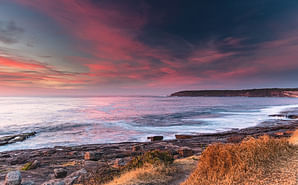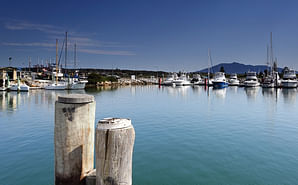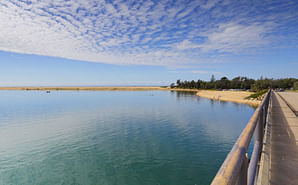Frequently Asked Questions (FAQs)
Common questions and answers in relation to the Merimbula STP and Ocean Outfall.

This project has generated extensive discussion in the community. Below are some of the common questions and answers in relation to:
FAQs
The Project
- Our current estimate is between $30 million and $40 million.
- Council has secured 25% State Government funding and is seeking Federal Government funding to minimise the impact to its customers. Third attempt at Federal funding awaiting notification of possible acceptance will be 50% of construction costs if successful.
- AECOM are one of the largest environmental consultants in the world. AECOM is our independent representative helping us to develop a concept design and environmental assessment for an ocean outfall and upgrade of the STP.
- We support the beneficial reuse of as much recycled water as possible from the Merimbula STP. However when it is wet and the capacity for re-use is limited the extra treated wastewater needs to go somewhere and currently it is sent to an outfall pipe on Merimbula Beach or to exfiltration ponds in the nearby sand dunes.
- The Merimbula beach-face ocean outfall no longer meets NSW Environment Protection Authority requirements or community expectations. The dunal exfiltration ponds have limited capacity and pose a risk to Merimbula lake and groundwater quality. The ponds are situated in endangered Bangalay Sand Forest and on land significant to Aboriginal people.
- Council is required to undertake development under the Environmental Planning and Assessment Amendment (Merimbula Sewage Treatment Plant and Ocean Outfall) Order 2016 under the Environmental Planning and Assessment Act 1979, section 115U (4).
- The works are considered NSW State Significant Infrastructure, will have to meet the Secretary’s Environmental Assessment Requirements and will require approval of the NSW Minister for the Environment.
- Public infrastructure is designated with State significance due to its size, economic value or potential impacts. More information is available at www.planningportal.nsw.gov.au.
- Consultation has been through many community drop-in information sessions, briefing sessions for key stakeholders, an agency and stakeholder focus group in 2009, a website and in December 2017, a Community Working Group was set up to represent the broader community.
- Consultation is continuing via information drop-in sessions at Merimbula’s beaches and Merimbula and Pambula markets.
- An Environmental Impact Statement (EIS) is being prepared for the project. The EIS is prepared to help the community, public authorities and the decision-makers to understand the likely impacts of the project and make informed submissions and decisions on the project. Some of the key assessments undertaken to inform the EIS are summarised below.
- Council and consultants (AECOM, Elgin, Ian Grey Groundwater Consulting and Manly Hydraulics) have been monitoring the treated wastewater quality from the STP and the water in Merimbula Bay.
- Studies have focused on the water quality, ocean currents and seabed characteristics in Merimbula Bay and the groundwater quality and flow within the dunes. The seabed investigations allow us to understand construction challenges such as rocky reefs.
- In November 2018, we carried out geotechnical investigations around the exfiltration ponds at the Sewage Treatment Plant. The results will be correlated with available historical information to help us understand ground conditions to inform infrastructure design.
- In October 2018, we completed heritage investigations at the STP and dunes to search the area for heritage items, including items of Aboriginal significance.
- We have undertaken two dye dispersion tests in Merimbula Bay (August 2017 and May 2018) to better understand the movement and dispersion of freshwater particles in the bay and to inform ocean modelling . By testing at different times of year and at different depths and locations, we will gain an improved understanding of how currents behave in different water temperatures and depths. Detailed ocean modelling has subsequently been carried out and will inform the EIS.
- In September 2017, we studied the flora and fauna in the area between the STP and Merimbula Bay, using direct observations (identifying a species or hearing a call) and indirect observations (identifying habitats, fur or tracks).
- Constructability, noise and vibration, traffic and air quality assessments have been commenced and will be completed as part of the EIS. These assessments focus on the impact of construction on the surrounding land and receivers.
- Social, economic, sustainability and climate change risk reporting will be included within the EIS.
- An EIS is almost complete and will look at the social, economic and environmental impacts of the construction and operation of the project.
- The EIS will be exhibited to the public in the first half of 2021. Once the exhibition period begins you will be able to make a submission on the project through the Department of Planning, Industry and Environment’s major projects page: Homepage | Major Projects - Department of Planning and Environment (nsw.gov.au)
- The EIS is to be reviewed by AECOM after Council's April 2024 meeting confirmed the original draft EIS is current and to be used which will require Ministers approval as part of the process to meet EPA’s requirements.
- Consultation has been through many community drop-in information sessions, briefing sessions for key stakeholders, an agency and stakeholder focus group in 2009, a website and in December 2017, a Community Working Group was set up to represent the broader community.
- The EIS will be exhibited for public comment in the first half of 2021. You can make a submission on the EIS through the Department of Planning, Industry and Environments major projects page: Homepage | Major Projects - Department of Planning and Environment (nsw.gov.au)
- Council is applying for an ISCA IS Rating for this project. The IS Rating Scheme evaluates sustainability across the planning, design, construction and operational phases of infrastructure projects and programs across Australia.
To find out more you can:
• Call toll-free 1800 029 478
• Email merimbulaSTPupgrade@begavalley.nsw.gov.au
• Follow Bega Valley Shire Council on Facebook
Merimbula STP
- The upgrade will improve the quality of treated wastewater and minimise public health and environmental risks with using and disposing treated wastewater.
A: With two treatment plants (Tathra and Bemboka) already utilising solar power, we are well on our way to bringing solar to all our most power-hungry water and sewerage assets, including the Merimbula Sewage Treatment Plant.
This combined $3 million investment over the next three years will, in the case of the Merimbula STP, offset 25% of the treatment plant’s annual power use and costs.
As our most power-hungry sewage treatment plant, the Merimbula STP will require an $860,000 investment to install a solar and BESS battery system that will pay for itself through savings within 9.5 years. Once paid for, the combined solar power output from our treatment plants will introduce significant savings to our annual energy costs and remove the equivalent of 123 cars from our roads every year.
An independent study by the NSW Department of Planning, Industry and Environment concluded that we have a viable business case for a ground-mounted solar PV system to be installed at the Merimbula Sewage Treatment Plant.
We are committed to installing the largest solar and battery system that our sites and budget will allow. While there are significant environmental gains made by recycling effluent to nearby sites such as Oaklands Farm and the Pambula Sporting Complex, it should be noted that expanding a solar array to offset the significant additional energy demands of pumping to distant sites is beyond what we can afford and limited to available space at the Merimbula STP. Any environmental gains would be lost in the high energy used to transport large volumes of effluent far from the treatment plant site.
A: An upgraded STP and deep-water outfall pipe plans for the future. Taking a higher quality effluent further out to sea will take advantage of natural marine currents and processes to disperse and greatly dilute the treated effluent.
Removing the need to use the dunal exfiltration ponds will relieve environmental pressure on the endangered bangalay sand forest ecosystem in the area.
Investigating options for increased wastewater reuse can ultimately reduce dependency and pressure on inland waterways and local catchments, which are used for irrigation of farm and recreational land.
As part of a $3 million investment over three years, we are investigating the installation of solar powered at our treatment plants. While it isn’t currently viable to fully power our energy-hungry treatment plants using solar alone, we are moving towards the partial powering of each of our 10 sites using power from the sun.
In addition to this, we currently reuse 100% of biosolids from our sewage treatment plants. This valuable resource is made available to local farmers who use it to improve soil health.
- Upgrades to the STP will be targeted to reduce nutrient concentrations, lower algae counts and improve disinfection.
- We collect sewage from our communities in Merimbula, Berrambool, Pambula, Pambula Beach, South Pambula and Millingandi. The largest proportion comes from residential and holiday dwelling showers, baths, washing machines, sinks and toilets. Total average inflow to the STP is about 700 million litres per year.
- You can look at the quality of our Merimbula STP treated wastewater (and that of all our other STPs) on our website at https://www.begavalley.nsw.gov.au/cp_themes/default/page.asp?p=DOC-NVK-33-17-88.
A: The cost of upgrading all of our wastewater treatment plants to this level is prohibitive. We simply do not have the available funds to implement this.
The beach-face outfall has caused community concern around its impact on the aquatic environment and public health. In 2009, the EPA required Council to start investigating better disposal options. After investigating a wide range of options, Council assessed the options with a community focus group made up of state government, interest groups and local community members.
In 2013, the group and Council agreed a deep ocean outfall is the preferred effluent disposal option. Compared to other options the deep ocean outfall has:
- the greatest environmental benefit through improving water quality and ecology
- least construction and operational impacts recognising the value the Merimbula community places on its beach and ocean fronts
- is more socially, environmentally and economically sustainable in the long term.
For more information about discounted options, visit: Fact Sheets 1 - 16 Merimbula Effluent Options Investigation (BVSC & AECOM 2013)
As a result, the EPA amended Council's operating licence for the STP to include a requirement to construct a deep-ocean outfall and upgrades to the STP.
- Our current NSW EPA license for the Merimbula STP specifies a 90th percentile limit of 10 mg/L for BOD5 which we have consistently achieved for several years. Normally, the BOD5 levels in the excess treated wastewater discharge from Merimbula STP are less than 2 mg/L which is as sensitive as our NATA-registered laboratory currently tests for.
- At this stage of the concept design and environmental impact study, the planned upgrade to the STP (for excess treated wastewater) will include:
- removal of additional phosphorous; and
- change in the disinfection process to include Ultra Violet light disinfection.).
Neither of these proposed upgrades will materially affect the BOD5 removal performance.
However, once the project team has finalised the EIS, we will be able to confirm any specific treatment upgrades that will be required (including for any further BOD5 removal).
Ocean Outfall
A: AECOM developed the Merimbula Effluent Management Options Study between 2009-2013. This study investigated strategic alternatives to the project including new and expanded re-use schemes as well as STP upgrade and disposal options. All schemes included the need for a disposal option.
Council currently partners with community groups, farmers and golf clubs to operate ten recycled water irrigation schemes between Bermagui in the north and Eden in the south. About a quarter of our community’s treated sewage is recycled and used beneficially in an average rainfall year. Council is looking to expand this scheme through developing a Recycled Water Strategy.
No scheme escapes the need for a back-up disposal option. In wetter times, demand for re-use drops and inflow to the STP spikes.
In addition to this, we currently reuse 100% of biosolids from our sewage treatment plants. This valuable resource is made available to local farmers who use it to improve soil health.
A: Currently, we pump treated effluent onto the beach, midway between Merimbula and Pambula. This is a blight on an otherwise visually stunning beach. It also poses the greatest risk for contamination as dilution and dispersal so close to the shore is minimal.
Our planned sewage treatment plant upgrade will take an improved quality effluent 2.7km out to sea where offshore currents will diffuse and dilute the effluent more than onshore processes can achieve.
In recognition of this, the NSW EPA has instructed us to upgrade the Merimbula Sewage Treatment Plant and construct a new ocean outfall pipe.
In the daytime and during summer, when we can’t use the existing outfall, treated wastewater is pumped into dunal exfiltration ponds behind Merimbula Beach.
Their ongoing use is unacceptable as they are constructed on culturally sensitive land of great significance to the local Aboriginal community and on endangered bangalay sand forest environments.
An ocean outfall pipe will remove the need for exfiltration ponds, which will be handed back to the local Aboriginal community.
A: While we are in a good position currently, with clean bay waters supporting healthy seafood and recreational businesses, we recognise there are ways to achieve better results through looking at cultural and environmental sensitivities, and planning for the future as the local population increases.
In 2009, the NSW EPA required Council to start investigating better disposal options. After investigating a wide range of options, Council assessed the options with a community focus group made up of state government, interest groups and local community members.
In 2013, the group and Council agreed a deep ocean outfall is the preferred option to cater for cultural and environmental needs, as well as increased pressure from population growth. Compared to other options the deep ocean outfall has:
-
the greatest environmental benefit through improving water quality and ecology
-
least construction and operational impacts recognising the value the Merimbula community places on its beach and ocean fronts
-
the least impact on culturally and environmentally sensitive areas
-
is more socially, environmentally and economically sustainable in the long term.
As a result, the EPA amended Council's operating licence for the Merimbula STP to include a requirement to construct an ocean outfall pipe, with upgrades to the STP.
A: Algal blooms are a naturally occurring phenomenon. The algae most experienced locally is Hincksia sordida, a resident of Merimbula Bay that often moves closer to shorelines due to the summer easterly and north-easterly winds. A 2013 independent study of algal blooms in Merimbula Bay found that nutrient content from treated effluent was only one of many food sources this type of algae utilised for growth. The study also found numerous accounts from long-term Merimbula residents indicating the presence of regular algal blooms as far back as the 1950s, more than 20 years before the commissioning of the Merimbula Sewage Treatment Plant.
- Yes, the EIS will establish an ongoing program of monitoring of any potentially impacted environment.
- The following assessments have already been carried out:
- In conjunction with Council, consultants from AECOM have been monitoring the STP and Merimbula Bay to inform the decision making about the STP upgrade and the best alignment for the ocean outfall.
- Studies have focused on the water in the bay and the ground below it, including above and below the seabed. Looking below the seabed allows us to understand construction challenges while looking above the seabed allows us to map formations like rocky reefs.
- We have carried out marine ecology studies, which have focused on the plants and animals in Merimbula Bay, the coastal waters to the north and south of the Bay, as well as Merimbula Lake and Pambula Lake.
- In November 2018, we carried out geotechnical investigations around the exfiltration ponds at the Sewage Treatment Plant. The results will be correlated with available historical information to help us understand ground conditions to inform infrastructure design.
- In October 2018, we completed heritage investigations at the STP to search the area for heritage items, including items of Aboriginal significance.
- We have done multiple dye dispersion tests in Merimbula Bay to understand how waterborne materials travel and spread in the bay’s currents. We did our first test in August 2017 and one in May 2018. By testing at different times of year and at different depths and locations, we can get a complete picture of how currents behave in different water temperatures and depths. This information has informed the preferred location for the ocean outfall.
- In September 2017, we did a flora and fauna study. Over several days, we looked for different plants and animals in the area between the STP and Merimbula Bay using direct observations (seeing a species or hearing a call) and indirect observations (seeing habitats, hair or tracks).
The beach-face outfall has been discharging treated wastewater at the centre of Merimbula Beach since 1974. The treated wastewater flows across the beach and into the ocean waters of Merimbula Bay.
- The original ocean outfall was commissioned in 1972 following the sewering of Merimbula, Pambula Beach and Pambula and construction of the Merimbula STP. It extended into the ocean and beyond the surf zone. In 1974 it was damaged by large seas and a temporary beach-face outfall was constructed. This temporary outfall remains in the same location to this day.
- Council has discussed the impact of the ocean outfall pipe on the artificial reef with NSW DPI Fisheries. Potential Impact on the artificial reef along with the other natural reefs in Merimbula Bay have been considered as part of the Environmental assessment. The assessment concludes there is minimal risk of impact to these reefs from the operation of the proposed outfall.
- Stormwater can reach the sewer system through groundwater infiltration or accidental inflow if gutters are connected incorrectly. This has a big effect on the volume of sewage that the STP has to treat and dispose of. In a big storm the STP can receive an entire weeks’ worth of sewage in one day.
- After prolonged rainfall, the beneficial reuse sites do not have the capacity or storage to take extra treated wastewater. The excess needs to go somewhere. Currently, it is sent to a beach-face outfall pipe on Merimbula Beach (or to exfiltration ponds in the nearby sand dunes), which is not acceptable or sustainable.
- All large sewerage schemes need a way to deal with the volume of treated wastewater unable to be reused.
- Coastal sewage treatment plants with ocean outfalls are very common. There are 30 active ocean outfalls along the NSW coast.
- The transfer pipeline from the STP will run mainly underground to a submerged diffuser located on the seabed. The preferred alignment has the diffuser located approximately 3.5km from the STP (2.7 km offshore).
- The diffuser releases treated wastewater in fine jets and makes sure that the treated wastewater is effectively mixed and diluted with ocean water.
- The preferred alignment would see the pipeline constructed between 10-20m beneath the sand dunes, via a trenchless drilling method Specialist contractors would be engaged to complete the detailed design and trenchless drilling works.
- The preferred diffuser location is approximately 30m deep.
- The preferred alignment would see the diffuser positioned 3.5km from the STP, centrally in Merimbula bay.
- Yes, the Environmental Impact Statement (EIS) will establish an ongoing program of monitoring of any potentially impacted environment.
- Read more about the Environmental Assessments that have been undertaken so far.
- Ocean outfalls pose fewer risks compared with river outfalls because river ecology is more sensitive and the conditions for mixing, dilution and dispersion are more limited.
- There has been considerable discussion regarding the merits of wetlands to help manage and treat the treated wastewater. Wetland environments are considerably more delicate than marine environments. The protected saltmarsh at Panboola for example could be severely impacted with regular inflows of fresh wastewater. Outflows would be via Merimbula and Pambula lakes, which could pose a risk to established seafood and recreational businesses. The NSW Coastal Management Act 2016 would not allow this option to happen.
- Constructed wetlands require a large land area and a discharge location for water flowing from them. There is no identified available land or suitable discharge location for a constructed wetland in the vicinity of Merimbula STP. Wetlands also have variable performance due to seasonal/climatic factors and fall outside NSW EPA licencing provisions.
- As our regulator, the EPA will not tolerate “out-of-sight-out-of-mind”. They want to see what and where the impacts are for all land and marine ecology.
Reuse
- Treated wastewater is either reused for irrigation or disposed of. Council reuses as much of it as possible for irrigation at Pambula Merimbula Golf Course and farmland at Oaklands. The remainder is disposed via the beach-face outfall or dunal exfiltration ponds. We are also investigating the possibility of re-using effluent for irrigation at the Pambula Sporting Complex
- Yes, we currently have 11 re-use schemes operating in the shire. The total amount of re-use fluctuates according to the weather. In financial year 2019/20, we beneficially re-used 40% of our effluent, which is far more than the state average of 13.4%. Also in that same year we recycled a higher percentage of effluent than any other coastal council in NSW.
- The golf club uses between 13% and 30% of the total volume of treated wastewater produced at Merimbula STP each year. More is used in dry years, less in wet. Median use is around 21% per year.
- Pambula Merimbula Golf Club has been using treated wastewater from Merimbula STP for 46 years.
- Oaklands Farm uses between 5% and 11% of the total volume of treated wastewater produced at Merimbula STP each year. More is used in dry years, less in wet. Median use is around 8% per year.
- Oaklands’ treated wastewater use scheme has been operating since February 2013. Treated wastewater is pumped through a 4km pipeline to a 20 million litre storage dam located on the Oaklands property.
- The Merimbula landscape is unique and there are constraints on where we can direct recycled water to; we must protect existing wetlands, endangered ecological communities, National Park areas, oyster leases and Aboriginal heritage sites.
- Land for reuse of recycled water typically needs to have suitable buffer zones from waterways, a slope less than 10 degrees and a suitable soil profile. It also needs to enable irrigation infrastructure that can be programmed to apply water when the vegetation requires it and operated to avoid overspray, spray drift, runoff, ponding and water-logging of soils.
- There are about 7 hectares of sports fields at the Pambula Sporting Complex that could benefit from water reuse. We are working on estimates for cost and reuse volume. There is a lot to think about when planning a new reuse scheme and Council has committed to developing a Recycled Water Management Project for the entire Shire.
- The Recycled Water Management Project will take a shire-wide approach to effluent recycling, looking at opportunities that can be planned for, costed and implemented strategically.
- The project will steer us away from an ad-hoc approach, focussing instead on creating a framework for delivering an overall increase in effluent re-use.
- Taking this approach will allow us to focus on locations better suited to large-scale effluent reuse, while identifying smaller opportunities in areas such as Pambula and Merimbula, where more barriers such as land use and geology exist.
- Community feedback is being processed from the recent water and sewer services survey, and the community will be consulted as part of the Recycled Water Management Project on what they are willing to pay to for Council to deliver increased re-use.
- Current concentration of phosphorus in the treated wastewater is about 9 milligrams per litre (mg/L). This has been a limiting factor for new treated wastewater use options.
- Current concentration of nitrogen in the treated wastewater is about 4 milligrams per litre (mg/L).
- When sewage is treated the organic solids are separated from the treated wastewater and matured in lagoons for around six months.
- The process is similar to a compost pile. The result is nutrient rich organic material called biosolids.
- Biosolids are stabilised and then supplied to local farms as a nutrient rich organic soil conditioner.
- Merimbula STP generates beneficial biosolids from all over the Shire. Biosolids from Cobargo, Wolumla, Candelo, Kalaru, Merimbula and Pambula are all processed at Merimbula STP.
- Before 2019 all the annual generation of 6,000 t/year of biosolids went to landfill. We now target 100% of that to be diverted to our contractor Arkwood to use on local farms. Whatever can not be re-used is reprocessed and used on-site at our sewage treatment plants. Almost all of our biosolids will now avoid landfill, and most will benefit local farmers.
- The exfiltration ponds were commissioned in 1991.






